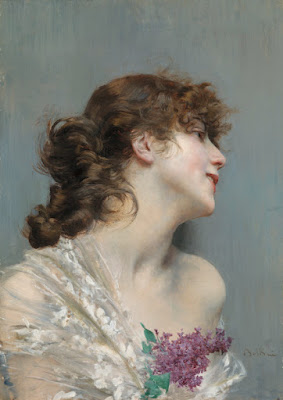 |
| Carl Christian Nahl Portrait of Catharina von Breithaupt 1845 oil on canvas Museumslandschaft Hessen Kassel |
 |
| Gabriel Max Monkey with Bouquet of Violets ca. 1880-90 oil on panel National Museum, Warsaw |
 |
| Josef Scheurenberg Portrait of a Lady 1881 oil on panel Museumslandschaft Hessen Kassel |
 |
| Giovanni Boldini Portrait of a Lady ca. 1885 oil on canvas Virginia Museum of Fine Arts, Richmond |
-1896-lithograph-(poster)-Kunstbibliothek-Staatliche-Museen-zu-Berlin.jpg) |
| Edward Penfield Harper's - March 1896 lithograph (poster) Kunstbibliothek, Staatliche Museen zu Berlin |
 |
| Thérèse Schwartze Mme. J.A.C. van Bilderbeek Lamaison van Heenvliet 1900 oil on canvas Dordrechts Museum |
 |
| Lovis Corinth Portrait of singer Frieda Halbe 1905 oil on canvas Belvedere Museum, Vienna |
 |
| Hanna Pauli Portrait of Kerstin Clason ca. 1911 oil on canvas Prins Eugens Waldemarsudde, Stockholm |
-Kunstbibliothek-Staatliche-Museen-zu-Berlin.jpg) |
| Heinrich Lessing Chemiserie Sonnenfeld 1913 lithograph (poster) Kunstbibliothek, Staatliche Museen zu Berlin |
-starring-Henny-Porten-1914-lithograph-(poster)-Kunstbibliothek-Staatliche-Museen-zu-Berlin.jpg) |
| Hans Rudi Erdt The Valley of Dreams starring Henny Porten 1914 lithograph (movie poster) Kunstbibliothek, Staatliche Museen zu Berlin |
 |
| Anton Kolig General Gottfried Seibt von Ringenhart 1918 oil on canvas Belvedere Museum, Vienna |
 |
| Christian Schad Maika Sprangermacher in Paris 1929 oil on canvas Von der Heydt Museum, Wuppertal |
 |
| Christopher Munthe Portrait of dancer Ingse Kaarsberg ca. 1930 oil on canvas Oslo City Museum |
 |
| Kerstin Bernhard Model at Dior 1949 gelatin silver print Moderna Museet, Stockholm |
-Portrait-of-soprano-Birgit-Nilsson-1969-color-photograph-Moderna-Museet-Stockholm.jpeg) |
| Benno Movin-Hermes Portrait of soprano Birgit Nilsson 1969 color photograph Moderna Museet, Stockholm |
 |
| Carlota Perla Caramellogram from Barcelona 2010 screenprint Moderna Museet, Stockholm |
Hydaspes, the Ethiopian king, had been in time to observe from a distance the Persian dash for Syene, but despite a vigorous pursuit had arrived too late to engage them before they entered the town. Thereupon he had unleashed his forces against the city, whose walls they encircled like a river, in numbers so vast that the mere sight of them made resistance inconceivable. . . . It was here that the scouting party found him and presented their prisoners. Joy welled in him at the sight of the young pair; he felt an instant attraction to his own flesh and blood, as, did he but know it, the prophetic intuition of his heart exerted its power over him. But he derived even greater joy from the omen afforded by the presentation of these bound prisoners.
"Excellent!" he exclaimed. "In the first spoils of war, the gods deliver our enemies bound into our hands! Let these, our first prisoners," he went on, "be kept safe for the victory sacrifices as the firstfruits of the war, for so Ethiopian law requires. They are to be kept under guard to be an offering to the gods of our homeland."
He rewarded the scouting party with gifts and sent them and their prisoners away to the supply train. He detailed a complete detachment of Greek-speakers to stand guard over the young pair and gave them instructions to spare no pains in catering to their needs and stint nothing in their care, but above all to keep them clean of all impurity, for they were now being kept as a pair of sacrificial victims. He also gave orders that their fetters were to be replaced with chains of gold, for in Ethiopia gold is customarily employed for the purposes for which other nations use iron.
The guards put these orders into effect. The removal of the first set of chains raised hopes in the two lovers that they were to be given their freedom, but these hopes were dashed when their guards loaded them with new chains, chains of gold. Theagenes could not contain his laughter. "A great improvement, I must say!" he exclaimed. "What kindness fortune is showing us! We change iron for gold, captivity brings us riches, and now we are aristocrats among prisoners!"
Charikleia smiled too and tried to brighten Theagenes' mood by reminding him of what the gods had foretold and beguiling him with happier hopes for the future.
– Heliodorus, from The Aethiopica, or, Theagenes and Charikleia (3rd or 4th century AD), translated from Greek by J.R. Morgan (1989)